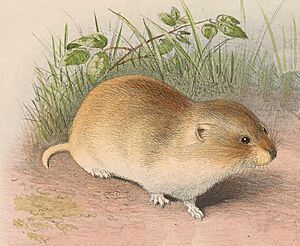Blyth's vole facts for kids
Quick facts for kids Blyth's vole |
|
|---|---|
 |
|
| Conservation status | |
| Scientific classification | |
| Genus: |
Neodon
|
| Species: |
leucurus
|
| Synonyms | |
|
Phaiomys leucurus |
|
The Blyth's vole (scientific name: Neodon leucurus) is a small, furry rodent. It belongs to the Cricetidae family, which includes hamsters and other voles. This little animal lives in the high mountains of northern India, Nepal, and China.
Blyth's voles are known for digging burrows and living together in small groups. They are found across a large area and are not currently facing major dangers. Because of this, the International Union for Conservation of Nature says they are a "least concern" animal. This means their population is stable and not at risk.
Contents
What Does a Blyth's Vole Look Like?
Blyth's voles are small creatures. Their body, from head to tail, measures about 98 and 128 mm (3.86 and 5.04 in) long. Their tail adds another 26 to 35 mm (1.02 to 1.38 in) to their length.
Their fur on their back is a light yellowish-brown color. Their belly is a yellowish-grey. These two colors blend smoothly where they meet. Their feet, both front and back, are yellowish-white. The tail is the same yellowish-brown color all over. Blyth's voles have small, round ears and long claws. These features help them live underground, as they are good for digging.
Where Do Blyth's Voles Live?
Blyth's voles live in the high mountains of northern India and Nepal. They are also found on the Tibetan Plateau in western China. This includes areas like Xinjiang, the Tibet Autonomous Region, and Qinghai. They live at very high altitudes, often above 4,500 m (14,800 ft).
These voles make their homes in forests and grassy mountain areas. They especially like to dig burrows near rivers and lakes. Sometimes, they tunnel under large rocks or use cracks in the rocks as shelter. In winter, they can even create pathways under the snow.
How Do Blyth's Voles Behave?
Blyth's voles are active during the day. They spend most of their time underground in deep burrow systems. Up to twenty voles can live together in one of these burrow colonies.
They eat plants and other vegetable matter. Female voles can have several babies at once. A mother vole can give birth to as many as seven young in a single litter.
Are Blyth's Voles Safe?
Blyth's voles are found over a wide area. Scientists believe there are many of them in total. While they haven't been recorded in many protected areas, their population seems stable.
No major threats have been found for these voles. The main concern is if their habitat changes or gets destroyed. However, the International Union for Conservation of Nature has assessed their status as "least concern." This means they are not currently at risk of disappearing.


